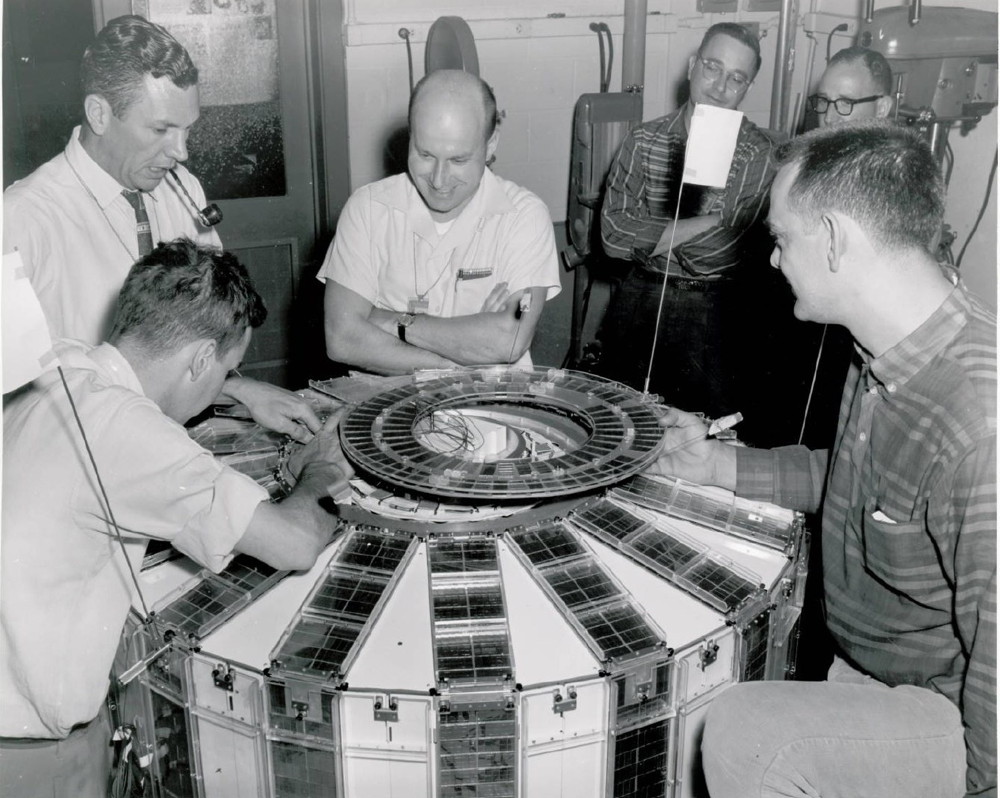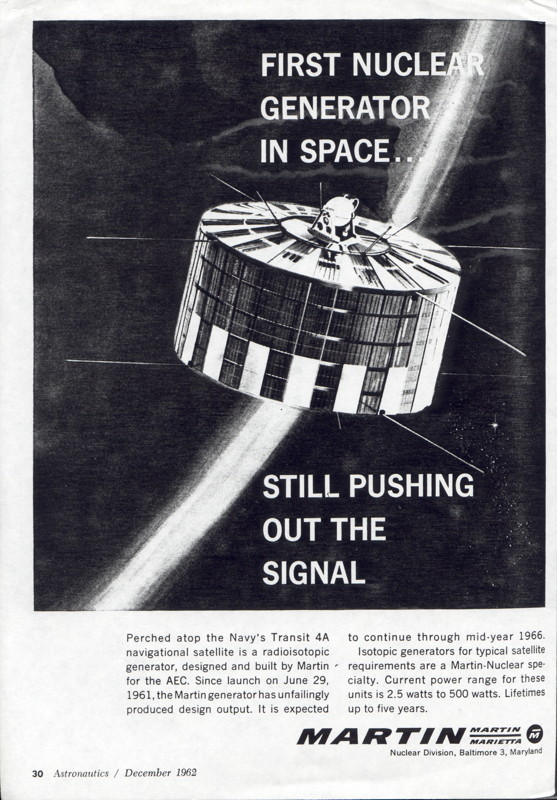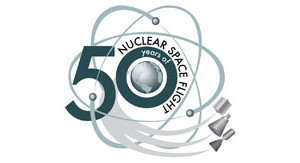50 Years of Nuclear-Powered Spacecraft: It All Started with Satellite Transit 4A

Consider this a nuclear blast from the past – all the way back to the early days of U.S. space missions, when the first satellite to use a radioactive power source launched into orbit.
The satellite, called Transit 4A, launched on June 29, 1961 atop a Thor-DM21 Able-Star rocket. The drum-shaped spacecraft weighed only 175 pounds and was laden with solar cells tied to nickel-cadmium batteries.
Fifty years ago, the Transit 4A satellite marked the first flight test of a nuclear power source developed for use in spacecraft. The repercussions stemming from this early satellite now stretch out throughout our known solar system … and beyond.
Constructed for the U.S. Navy's Bureau of Naval Weapons, a primary duty of Transit 4A was to serve as one of four operational navigational satellites for use by ships and aircraft. More specifically, these satellites updated the inertial navigation systems on board U.S. Navy Polaris submarines that were locked and loaded with nuclear-tipped missiles. [Most Destructive Space Weapons]
The Earth-orbiting Transit 4A was built by the Applied Physics Laboratory of Johns Hopkins University.
But here’s the central message: This 1960s vintage vessel heralded a major milestone in the olden times of space technology.
SNAP decision
Breaking space news, the latest updates on rocket launches, skywatching events and more!
Transit 4A's radioisotope thermoelectric generator (RTG) used Plutonium 238 for fuel. The process – called the Seebeck effect – involves direct conversion of the heat generated by the decay of Pu-238 oxide to electrical energy. In the device, heat released by the decay of the radioactive material is converted into electricity using an array of thermocouples.
Attached to Transit 4A was the powerful space battery, the SNAP-3B7, a snappy but short substitute for Systems for Nuclear Auxiliary Power.
The prime contractor for the SNAP-3 program was The Martin Company (Nuclear Division), which is now part of Teledyne Energy Systems. This energy supply operated for 15 years, powering a pair of beacons carried by the spacecraft. The nuclear battery churned out all of 2.7 watts of electrical power.
The U.S. Department of Energy (DOE) has provided RTGs for space applications since 1961. Between 1961 and 1972, DOE provided power systems for six Navy navigational satellites. In addition, DOE provided power systems for two Air Force communications satellites, LES 8 and LES 9, both launched together on March 14, 1976.
Long track record
There's a robotic space exploration ancestry given DOE-supplied RTGs. They have been on Pioneer spacecraft that went to Jupiter and Saturn; the Viking Mars landers; the Voyager spacecraft that scooted by Jupiter, Saturn, Uranus and Neptune; the Galileo spacecraft that orbited Jupiter; the Cassini spacecraft now circling Saturn; and the New Horizons spacecraft presently on its way to Pluto. [Cassini Photos of Saturn's Rings and Moons]
Also, Apollo missions 12 through 17 toted RTGs to the moon to run science gear on the lunar surface.
That track record is indeed impressive. But the launch of nuclear-powered craft also fuels controversy, concern, law suits, even protests — a sidebar to the story of space nuclear power.
The specter of a launch failure or an out-of-control Earth flyby of a spacecraft loaded with nuclear fuel have spurred worries in some quarters. In response, NASA and DOE have responded by risk assessments, safety reviews, as well as engineering RTGs to be super-safe by design.
Debate aside, five decades ago, the Transit 4A remains the little spacecraft that could thanks to its nuclear power-pack.
A problem that needed solving
John Dassoulas was one of the key people at Johns Hopkins University Applied Physics Laboratory, the group that built the Transit 4A satellite. During the time, among a number of job titles, he was in charge of spacecraft launch operations.
Dassoulas recalls that back in the late 1950s into the 1960s, there were no reliable space parts available.
"I mean, reliability hadn’t even entered the picture. We weren’t even sure that the batteries were going to last for five years. So that was our motivation to begin looking into other kinds of power sources," Dassoulas told SPACE.com.
As for the notable nature of building and launching the nuclear-powered Transit 4A, Dassoulas said: "We didn't think about the historical aspects of this thing at all. The Cold War was well under way. The transit system was invented to solve a problem that needed solving … for the good of the country and the needs of the services."
Dassoulas said when he looks back on those times, "it was just as amazing in those early days as the amazement is today. Nobody had done what we did. And we had one grand party after that launch, I tell you."
Also looking back on the orbiting of Transit 4A is Paul Dick, then a young aerospace engineer and the Martin Company's project manager for the SNAP-3 RTG program.
"My biggest never-to-be forgotten remembrance occurred when John Dassoulas informed me of obtaining successful orbit parameters over the Philippines … and that the SNAP 3A-powered transmitters were being received loud and clear," he said.
Dick said he also recalls that the then-Atomic Energy Commission, on the 10th anniversary of the launch, publicly announced that even though the main solar powered transmitters on Transit 4A had ceased to operate, the SNAP 3A- powered mini-system was still transmitting signals.
Exploration lineage
"For most people, the major benefit of the Navy's Transit program has been that it paved the way for today’s Global Positioning System, which has greatly aided worldwide navigation," said Gary Bennett, a former NASA manager of advanced space power systems who has held key positions in DOE's space radioisotope power program in the past.
"But for the space science community, the major benefit of the Transit 4A program is that it showed that nuclear power could provide electricity to operate spacecraft sensors and components."
That being the case, it meant that scientific spacecraft flung outward into the outer solar system would not lack for electrical power.
"In short, the entire solar system was now open for scientific exploration," Bennett told SPACE.com. Now available are radioisotope power sources that can produce over 100 times what Transit 4A's RTG yielded.
The universe still awaits
Moreover, there is a direct link from those first small steps with SNAP-3B on Transit 4A, Bennett pointed out.
"Thanks to nuclear power, spacecraft are going where no spacecraft dared to go before," Bennett said. "It has been a grand adventure … and the universe still awaits!"
For good measure, toss in the sendoff later this year of NASA's Curiosity Mars rover. This large and highly mobile robot will derive its electrical power from a Multi-Mission Radioisotope Thermoelectric Generator (MMRTG).
Similar to the radioisotope power systems of the past, MMRTG contains 10.6 pounds (4.8 kilograms) of plutonium dioxide as the source of the steady supply of heat used to produce the onboard electricity and to warm the rover’s innards during the frosty Martian hours of darkness.
To be sure, Curiosity’s prowling around on the Red Planet underscores a long-heralded nuclear maxim for the space community: "Nukes do it all night!"
Leonard David has been reporting on the space industry for more than five decades. He is a winner of this year's National Space Club Press Award and a past editor-in-chief of the National Space Society's Ad Astra and Space World magazines. He has written for SPACE.com since 1999.

Leonard David is an award-winning space journalist who has been reporting on space activities for more than 50 years. Currently writing as Space.com's Space Insider Columnist among his other projects, Leonard has authored numerous books on space exploration, Mars missions and more, with his latest being "Moon Rush: The New Space Race" published in 2019 by National Geographic. He also wrote "Mars: Our Future on the Red Planet" released in 2016 by National Geographic. Leonard has served as a correspondent for SpaceNews, Scientific American and Aerospace America for the AIAA. He has received many awards, including the first Ordway Award for Sustained Excellence in Spaceflight History in 2015 at the AAS Wernher von Braun Memorial Symposium. You can find out Leonard's latest project at his website and on Twitter.



